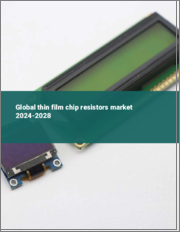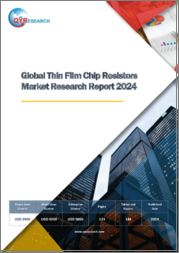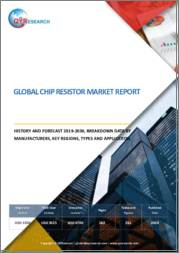
|
시장보고서
상품코드
1702029
칩 저항기 시장 보고서 : 유형별, 기술별, 최종 용도별, 지역별(2025-2033년)Chip Resistor Market Report by Type, Technology, End Use, and Region 2025-2033 |
||||||
세계의 칩 저항기 시장 규모는 2024년에 12억 5,100만 달러에 달했습니다. 향후 IMARC Group은 시장이 2033년까지 19억 2,100만 달러에 달하며, 2025-2033년의 성장률(CAGR)은 4.9%를 보일 것으로 예측하고 있습니다. 이 시장은 주로 전자제품의 고정밀 부품 소형화, 전기자동차의 고전력 저항기 수요 증가, 후막 및 박막 기술의 지속적인 개선으로 전체 용도의 성능, 내구성 및 신뢰성이 향상되고 있으므로 성장세를 보이고 있습니다.
표면 실장 소자 또는 SMD 저항기라고도 하는 칩 저항기는 전류의 흐름에 저항하도록 설계된 집적회로(IC) 소자를 말합니다. 칩 저항기는 일반적으로 금속 필름 또는 금속 산화물을 사용하여 작은 직사각형 또는 정사각형 칩 묶음으로 제조되며 얇은 보호 필름의 다층으로 덮여 있습니다. 현재 칩 저항기는 고정 저항과 가변 저항의 변형으로 널리 사용되고 있습니다. 칩 저항기는 뛰어난 안정성, 온도에 대한 내성 및 방열 특성으로 인해 주로 첨단 전자제품의 회로를 작동, 보호 및 제어하는 데 사용됩니다. 그 결과, 칩 저항기는 CE(Consumer Electronics), 자동차, 운송, 의료, 정보 기술(IT), 통신 등 다양한 산업 분야에서 폭넓게 사용되고 있습니다.
칩 저항기 시장 동향 :
스마트폰, 노트북, 스마트 TV, 차량용 레코더, 스피커 등 소비자 전자제품의 사용이 증가하고 있는 것이 시장 성장을 가속하는 주요 요인입니다. 또한 전자기기의 소형화라는 새로운 동향과 소형 기기에 대한 수요 증가로 인해 기존 리드 저항기보다 비용 효율적이고 크기가 작은 칩 저항기의 채택이 가속화되고 있습니다. 이와 더불어, 주요 제조업체들은 혁신적인 제품을 출시하고 제품 포트폴리오를 확장하기 위해 연구개발(R&D) 활동에 많은 투자를 하고 있습니다. 예를 들어 산업용 로봇 및 차량용 전자제어장비(ECU)의 정밀도를 높이고 ESD 위험을 줄이기 위해 가장 강력한 정전기 방전(ESD) 보호 기능을 갖춘 고정밀 박막 칩 저항기를 개발했습니다. 또한 하이엔드 자동차 및 하이브리드 전기자동차의 판매량 증가로 자동차 부품에 사용되는 제품 수요가 증가하고 있습니다. 이 외에도 다양한 최종 사용 분야의 디지털화 발전, 4G 및 5G 기술 채택 확대, 급속한 도시화, 소비자의 가처분 소득 증가 등도 시장 전망을 밝게 하고 있습니다.
이 보고서에서 다룬 주요 질문
- 2024년 세계 칩 저항기 시장 규모는?
- 세계 칩 저항기 시장의 2025-2033년 예상 성장률은?
- 세계 칩 저항기 시장을 촉진하는 주요 요인은?
- COVID-19가 세계 칩 저항기 시장에 미치는 영향은?
- 세계 칩 저항기 시장의 기술별 분석은?
- 세계 칩 저항기 시장 최종 용도별 분석은?
- 세계 칩 저항기 시장의 주요 지역은?
- 세계 칩 저항기 시장의 주요 기업은?
목차
제1장 서문
제2장 조사 범위와 조사 방법
- 조사의 목적
- 이해관계자
- 데이터 소스
- 1차 정보
- 2차 정보
- 시장 추정
- 보텀업 어프로치
- 톱다운 어프로치
- 조사 방법
제3장 개요
제4장 서론
- 개요
- 주요 업계 동향
제5장 세계의 칩 저항기 시장
- 시장 개요
- 시장 실적
- COVID-19의 영향
- 시장 예측
제6장 시장 내역 : 유형별
- 감압형
- 감열형
- 기타
제7장 시장 내역 : 기술별
- 후형 칩 저항기
- 박형 칩 저항기
- 기타
제8장 시장 내역 : 최종 용도별
- 자동차·운송
- CE(Consumer Electronics)
- 산업
- IT·통신
- 기타
제9장 시장 내역 : 지역별
- 북미
- 미국
- 캐나다
- 아시아태평양
- 중국
- 일본
- 인도
- 한국
- 호주
- 인도네시아
- 기타
- 유럽
- 독일
- 프랑스
- 영국
- 이탈리아
- 스페인
- 러시아
- 기타
- 라틴아메리카
- 브라질
- 멕시코
- 기타
- 중동 및 아프리카
- 시장 내역 : 국가별
제10장 SWOT 분석
- 개요
- 강점
- 약점
- 기회
- 위협
제11장 밸류체인 분석
제12장 Porter's Five Forces 분석
- 개요
- 바이어의 교섭력
- 공급 기업의 교섭력
- 경쟁의 정도
- 신규 진출업체의 위협
- 대체품의 위협
제13장 가격 분석
제14장 경쟁 구도
- 시장 구조
- 주요 기업
- 주요 기업의 개요
- Bourns Inc.
- International Manufacturing Services Inc
- Koa Corporation
- Panasonic Corporation
- Rohm Semiconductor
- Samsung Electro-Mechanics
- Susumu International U.S.A.
- TE Connectivity
- TT Electronics Plc
- Viking Tech Corporation
- Vishay Intertechnology Inc.
- YAGEO Group
The global chip resistor market size reached USD 1,251 Million in 2024. Looking forward, IMARC Group expects the market to reach USD 1,921 Million by 2033, exhibiting a growth rate (CAGR) of 4.9% during 2025-2033. The market is primarily driven by the emerging trend of miniaturization for high-precision components in electronics, increasing demand for high-power resistors in electric vehicles, and constant improvements in thick and thin film technologies, enhancing performance, durability, and reliability across applications.
Chip resistors, also known as surface-mount devices or SMD resistors, refer to integrated circuit (IC) devices designed to oppose the flow of electric current. They are typically manufactured in small rectangular or square chip bundles using metal films or metal oxides and covered with multiple layers of a thin protective coating. Nowadays, chip resistors are widely available in fixed and variable resistance variants. They are primarily utilized to operate, protect and control circuits in advanced electronics due to their excellent stability, resistance to temperature, and heat dissipation properties. As a result, chip resistors find extensive applications across numerous industries, including consumer electronics, automotive, transportation, healthcare, information technology (IT) and telecom.
Chip Resistor Market Trends:
The increasing usage of consumer electronics, such as smartphones, laptops, smart TVs, automotive logging devices, and speakers, represents the primary factor driving the market growth. Additionally, the emerging trend of electronics miniaturization and the escalating demand for compact devices are accelerating the adoption of chip resistors as they are more cost-efficient and smaller than traditional lead resistors. Besides this, the leading manufacturers are investing heavily in research and development (R&D) activities to launch innovative product variants and expand their product portfolio. For instance, they have developed a high precision thin film chip resistor with the most robust electro-static discharge (ESD) protection to enhance accuracy and reduce the risks of ESDs in industrial robots and automotive electronic control units (ECUs). Furthermore, the increasing sales of high-end automobiles and hybrid electric vehicles are catalyzing the product demand for use in automotive components. Other factors, including the rising digitization across various end use sectors, growing adoption of 4G and 5G technology, rapid urbanization and inflating consumer disposable incomes, are also creating a positive market outlook.
Key Market Segmentation:
Breakup by Type:
- Pressure-Sensitive
- Thermosensitive
- Others
Breakup by Technology:
- Thick Chip Resistors
- Thin Chip Resistors
- Others
Breakup by End Use:
- Automotive and Transportation
- Consumer Electronics
- Industrial
- IT and Telecommunication
- Others
Breakup by Region:
- North America
- United States
- Canada
- Asia-Pacific
- China
- Japan
- India
- South Korea
- Australia
- Indonesia
- Others
- Europe
- Germany
- France
- United Kingdom
- Italy
- Spain
- Russia
- Others
- Latin America
- Brazil
- Mexico
- Others
- Middle East and Africa
Competitive Landscape:
The competitive landscape of the industry has also been examined along with the profiles of the key players being Bourns Inc., International Manufacturing Services Inc, Koa Corporation, Panasonic Corporation, Rohm Semiconductor, Samsung Electro-Mechanics, Susumu International U.S.A., TE Connectivity, TT Electronics Plc, Viking Tech Corporation, Vishay Intertechnology Inc. and YAGEO Group.
Key Questions Answered in This Report
- 1.What was the size of the global chip resistor market in 2024?
- 2.What is the expected growth rate of the global chip resistor market during 2025-2033?
- 3.What are the key factors driving the global chip resistor market?
- 4.What has been the impact of COVID-19 on the global chip resistor market?
- 5.What is the breakup of the global chip resistor market based on the technology?
- 6.What is the breakup of the global chip resistor market based on the end use?
- 7.What are the key regions in the global chip resistor market?
- 8.Who are the key players/companies in the global chip resistor market?
Table of Contents
1 Preface
2 Scope and Methodology
- 2.1 Objectives of the Study
- 2.2 Stakeholders
- 2.3 Data Sources
- 2.3.1 Primary Sources
- 2.3.2 Secondary Sources
- 2.4 Market Estimation
- 2.4.1 Bottom-Up Approach
- 2.4.2 Top-Down Approach
- 2.5 Forecasting Methodology
3 Executive Summary
4 Introduction
- 4.1 Overview
- 4.2 Key Industry Trends
5 Global Chip Resistor Market
- 5.1 Market Overview
- 5.2 Market Performance
- 5.3 Impact of COVID-19
- 5.4 Market Forecast
6 Market Breakup by Type
- 6.1 Pressure-Sensitive
- 6.1.1 Market Trends
- 6.1.2 Market Forecast
- 6.2 Thermosensitive
- 6.2.1 Market Trends
- 6.2.2 Market Forecast
- 6.3 Others
- 6.3.1 Market Trends
- 6.3.2 Market Forecast
7 Market Breakup by Technology
- 7.1 Thick Chip Resistors
- 7.1.1 Market Trends
- 7.1.2 Market Forecast
- 7.2 Thin Chip Resistors
- 7.2.1 Market Trends
- 7.2.2 Market Forecast
- 7.3 Others
- 7.3.1 Market Trends
- 7.3.2 Market Forecast
8 Market Breakup by End Use
- 8.1 Automotive and Transportation
- 8.1.1 Market Trends
- 8.1.2 Market Forecast
- 8.2 Consumer Electronics
- 8.2.1 Market Trends
- 8.2.2 Market Forecast
- 8.3 Industrial
- 8.3.1 Market Trends
- 8.3.2 Market Forecast
- 8.4 IT and Telecommunication
- 8.4.1 Market Trends
- 8.4.2 Market Forecast
- 8.5 Others
- 8.5.1 Market Trends
- 8.5.2 Market Forecast
9 Market Breakup by Region
- 9.1 North America
- 9.1.1 United States
- 9.1.1.1 Market Trends
- 9.1.1.2 Market Forecast
- 9.1.2 Canada
- 9.1.2.1 Market Trends
- 9.1.2.2 Market Forecast
- 9.1.1 United States
- 9.2 Asia-Pacific
- 9.2.1 China
- 9.2.1.1 Market Trends
- 9.2.1.2 Market Forecast
- 9.2.2 Japan
- 9.2.2.1 Market Trends
- 9.2.2.2 Market Forecast
- 9.2.3 India
- 9.2.3.1 Market Trends
- 9.2.3.2 Market Forecast
- 9.2.4 South Korea
- 9.2.4.1 Market Trends
- 9.2.4.2 Market Forecast
- 9.2.5 Australia
- 9.2.5.1 Market Trends
- 9.2.5.2 Market Forecast
- 9.2.6 Indonesia
- 9.2.6.1 Market Trends
- 9.2.6.2 Market Forecast
- 9.2.7 Others
- 9.2.7.1 Market Trends
- 9.2.7.2 Market Forecast
- 9.2.1 China
- 9.3 Europe
- 9.3.1 Germany
- 9.3.1.1 Market Trends
- 9.3.1.2 Market Forecast
- 9.3.2 France
- 9.3.2.1 Market Trends
- 9.3.2.2 Market Forecast
- 9.3.3 United Kingdom
- 9.3.3.1 Market Trends
- 9.3.3.2 Market Forecast
- 9.3.4 Italy
- 9.3.4.1 Market Trends
- 9.3.4.2 Market Forecast
- 9.3.5 Spain
- 9.3.5.1 Market Trends
- 9.3.5.2 Market Forecast
- 9.3.6 Russia
- 9.3.6.1 Market Trends
- 9.3.6.2 Market Forecast
- 9.3.7 Others
- 9.3.7.1 Market Trends
- 9.3.7.2 Market Forecast
- 9.3.1 Germany
- 9.4 Latin America
- 9.4.1 Brazil
- 9.4.1.1 Market Trends
- 9.4.1.2 Market Forecast
- 9.4.2 Mexico
- 9.4.2.1 Market Trends
- 9.4.2.2 Market Forecast
- 9.4.3 Others
- 9.4.3.1 Market Trends
- 9.4.3.2 Market Forecast
- 9.4.1 Brazil
- 9.5 Middle East and Africa
- 9.5.1 Market Trends
- 9.5.2 Market Breakup by Country
- 9.5.3 Market Forecast
10 SWOT Analysis
- 10.1 Overview
- 10.2 Strengths
- 10.3 Weaknesses
- 10.4 Opportunities
- 10.5 Threats
11 Value Chain Analysis
12 Porters Five Forces Analysis
- 12.1 Overview
- 12.2 Bargaining Power of Buyers
- 12.3 Bargaining Power of Suppliers
- 12.4 Degree of Competition
- 12.5 Threat of New Entrants
- 12.6 Threat of Substitutes
13 Price Analysis
14 Competitive Landscape
- 14.1 Market Structure
- 14.2 Key Players
- 14.3 Profiles of Key Players
- 14.3.1 Bourns Inc.
- 14.3.1.1 Company Overview
- 14.3.1.2 Product Portfolio
- 14.3.2 International Manufacturing Services Inc
- 14.3.2.1 Company Overview
- 14.3.2.2 Product Portfolio
- 14.3.3 Koa Corporation
- 14.3.3.1 Company Overview
- 14.3.3.2 Product Portfolio
- 14.3.3.3 Financials
- 14.3.4 Panasonic Corporation
- 14.3.4.1 Company Overview
- 14.3.4.2 Product Portfolio
- 14.3.4.3 Financials
- 14.3.4.4 SWOT Analysis
- 14.3.5 Rohm Semiconductor
- 14.3.5.1 Company Overview
- 14.3.5.2 Product Portfolio
- 14.3.5.3 Financials
- 14.3.5.4 SWOT Analysis
- 14.3.6 Samsung Electro-Mechanics
- 14.3.6.1 Company Overview
- 14.3.6.2 Product Portfolio
- 14.3.6.3 Financials
- 14.3.6.4 SWOT Analysis
- 14.3.7 Susumu International U.S.A.
- 14.3.7.1 Company Overview
- 14.3.7.2 Product Portfolio
- 14.3.8 TE Connectivity
- 14.3.8.1 Company Overview
- 14.3.8.2 Product Portfolio
- 14.3.8.3 Financials
- 14.3.8.4 SWOT Analysis
- 14.3.9 TT Electronics Plc
- 14.3.9.1 Company Overview
- 14.3.9.2 Product Portfolio
- 14.3.9.3 Financials
- 14.3.9.4 SWOT Analysis
- 14.3.10 Viking Tech Corporation
- 14.3.10.1 Company Overview
- 14.3.10.2 Product Portfolio
- 14.3.10.3 Financials
- 14.3.11 Vishay Intertechnology Inc.
- 14.3.11.1 Company Overview
- 14.3.11.2 Product Portfolio
- 14.3.11.3 Financials
- 14.3.11.4 SWOT Analysis
- 14.3.12 YAGEO Group
- 14.3.12.1 Company Overview
- 14.3.12.2 Product Portfolio
- 14.3.12.3 Financials
- 14.3.1 Bourns Inc.
















